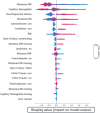Pilot deployment of a machine-learning enhanced prediction of need for hemorrhage resuscitation after trauma - the ShockMatrix pilot study
- PMID: 39468585
- PMCID: PMC11520814
- DOI: 10.1186/s12911-024-02723-9
Pilot deployment of a machine-learning enhanced prediction of need for hemorrhage resuscitation after trauma - the ShockMatrix pilot study
Abstract
Importance: Decision-making in trauma patients remains challenging and often results in deviation from guidelines. Machine-Learning (ML) enhanced decision-support could improve hemorrhage resuscitation.
Aim: To develop a ML enhanced decision support tool to predict Need for Hemorrhage Resuscitation (NHR) (part I) and test the collection of the predictor variables in real time in a smartphone app (part II).
Design, setting, and participants: Development of a ML model from a registry to predict NHR relying exclusively on prehospital predictors. Several models and imputation techniques were tested. Assess the feasibility to collect the predictors of the model in a customized smartphone app during prealert and generate a prediction in four level-1 trauma centers to compare the predictions to the gestalt of the trauma leader.
Main outcomes and measures: Part 1: Model output was NHR defined by 1) at least one RBC transfusion in resuscitation, 2) transfusion ≥ 4 RBC within 6 h, 3) any hemorrhage control procedure within 6 h or 4) death from hemorrhage within 24 h. The performance metric was the F4-score and compared to reference scores (RED FLAG, ABC). In part 2, the model and clinician prediction were compared with Likelihood Ratios (LR).
Results: From 36,325 eligible patients in the registry (Nov 2010-May 2022), 28,614 were included in the model development (Part 1). Median age was 36 [25-52], median ISS 13 [5-22], 3249/28614 (11%) corresponded to the definition of NHR. A XGBoost model with nine prehospital variables generated the best predictive performance for NHR according to the F4-score with a score of 0.76 [0.73-0.78]. Over a 3-month period (Aug-Oct 2022), 139 of 391 eligible patients were included in part II (38.5%), 22/139 with NHR. Clinician satisfaction was high, no workflow disruption observed and LRs comparable between the model and the clinicians.
Conclusions and relevance: The ShockMatrix pilot study developed a simple ML-enhanced NHR prediction tool demonstrating a comparable performance to clinical reference scores and clinicians. Collecting the predictor variables in real-time on prealert was feasible and caused no workflow disruption.
Keywords: Decision Support; Machine Learning; Prediction tool; Shock; Trauma.
© 2024. The Author(s).
Conflict of interest statement
TG reports honoraria from Laboratoire du Biomédicament Français. JDM reports honoraria from Octapharma. MW reports honoraria from Edwards. AH reports honoraria from Laboratoire du Biomédicament Français, Edwards and Octapharma. VR reports honoraria from Pfizer.
Figures





References
-
- Wohlgemut JM, Kyrimi E, Stoner RS, Pisirir E, Marsh W, Perkins ZB, et al. The outcome of a prediction algorithm should be a true patient state rather than an available surrogate. J Vasc Surg. 2022;75:1495–6. 10.1016/j.jvs.2021.10.059. - PubMed
-
- Rice TW, Morris S, Tortella BJ, Wheeler AP, Christensen MC. Deviations from evidence-based clinical management guidelines increase mortality in critically injured trauma patients*. Crit Care Med. 2012;40:778–86. 10.1097/CCM.0b013e318236f168. - PubMed
-
- Lang E, Neuschwander A, Favé G, Abback P-S, Esnault P, Geeraerts T, et al. Clinical decision support for severe trauma patients: Machine learning based definition of a bundle of care for hemorrhagic shock and traumatic brain injury. J Trauma Acute Care Surg. 2022;92:135–43. 10.1097/TA.0000000000003401. - PubMed
-
- van Maarseveen OEC, Ham WHW, van de Ven NLM, Saris TFF, Leenen LPH. Effects of the application of a checklist during trauma resuscitations on ATLS adherence, team performance, and patient-related outcomes: a systematic review. Eur J Trauma Emerg Surg. 2020;46:65–72. 10.1007/s00068-019-01181-7. - PMC - PubMed
MeSH terms
LinkOut - more resources
Full Text Sources
Medical

